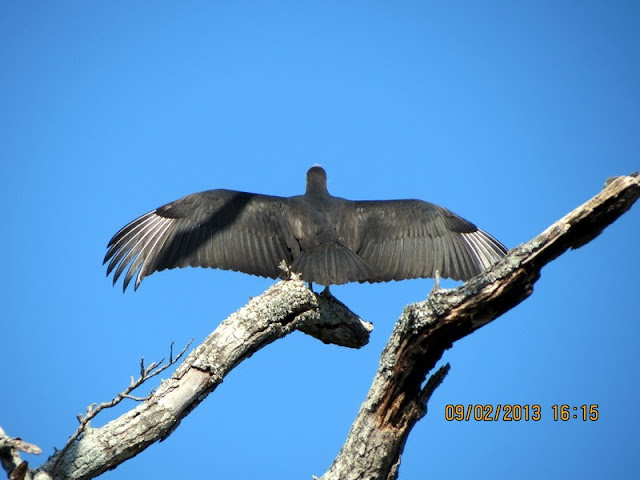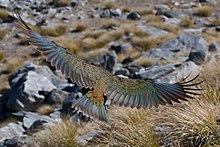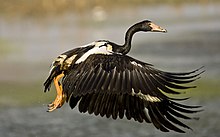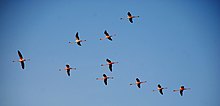After months of growing, Baby Buzz reveals his grown up Wings! What a set of wings he has. He wanted me to title the post: Hot Wings N Things. I had to explain to him that humans think of "Hot Wings" as something to eat. So, we settled on Wing Wow! Your infostudy tonight from Wikipedia is about how wings work. Baby Buzz is the result of a cross species mating between a Black Vulture Female (Lucy) and a Turkey Buzzard (or Vulture)(King Buzz). His wings are a "first" new design in Nature. He does not fly too much yet. (Mostly, he sits like a statue in the tree across the street). He is very clumsey landing! When he soars in the clouds, he excels as a flying wonder beyond whatever humans could dream up! Enjoy! (Surprise Ending)
https://en.wikipedia.org/wiki/Bird_flight
Bird flight
From Wikipedia, the free encyclopedia
Flight is the main mode of locomotion used by most of the world's bird species. Flight assists birds while feeding, breeding and avoiding predators.
This article discusses the mechanics of bird flight, with emphasis on the varied forms of bird's wings. The specifics of hovering, take-off and landing are also examined. Additional adaptations of bird's bodies relating to their flying ability are covered. Finally, theories on the evolution of bird flight are discussed.

Wing
The bird's forelimbs, the wings, are the key to bird flight. Each wing has a central vane to hit the wind, composed of three limb bones, the humerus, ulna and radius. The hand, or manus, which ancestrally was composed of five digits, is reduced to three digits (digit II, III and IV or I, II, III depending on the scheme followed[2]), which serves as an anchor for the primaries, one of two groups of flight feathers responsible for the wing's airfoil shape. The other set of flight feathers, behind the carpal joint on the ulna, are called the secondaries. The remaining feathers on the wing are known as coverts, of which there are three sets. The wing sometimes has vestigial claws. In most species these are lost by the time the bird is adult (such as the highly visible ones used for active climbing by Hoatzin chicks), but claws are retained into adulthood by theSecretary Bird, screamers, finfoots, ostriches, several swifts and numerous others, as a local trait, in a few specimens. The claws of the Jurassic theropod-like Archaeopteryx are quite similar to those of the Hoatzin nestlings.
Albatrosses have locking mechanism in the wing joints that reduce the strain on the muscles during soaring flight.[3]
Female birds exposed to predators during ovulation produce chicks which grow their wings faster than chicks produced by predator-free females. Their wings are also longer. Both adaptations may make them better at avoiding avian predators.[4]
Wing shape and flight
The shape of the wing is an important factor in determining the types of flight of which the bird is capable. Different shapes correspond to different trade-offs between beneficial characteristics, such as speed, low energy use, and maneuverability. Theplanform of the wing (the shape of the wing as seen from below) can be described in terms of two parameters, aspect ratio and wing loading. Aspect ratio is the ratio ofwingspan to the mean of its chord (or the square of the wingspan divided by wing area). Wing loading is the ratio of weight to wing area.
Most kinds of bird wing can be grouped into four types, with some falling between two of these types. These types of wings are elliptical wings, high speed wings, high aspect ratio wings and soaring wings with slots.
- Elliptical wings
Elliptical wings are short and rounded, having a low aspect ratio, allowing for tight maneuvering in confined spaces such as might be found in dense vegetation. As such they are common in forest raptors (such as Accipiter hawks), and many passerines, particularly non-migratory ones (migratory species have longer wings). They are also common in species that use a rapid take off to evade predators, such as pheasantsand partridges.
- High speed wings
High speed wings are short, pointed wings that when combined with a heavy wing loading and rapid wingbeats provide an energetically expensive high speed. This type of flight is used by the bird with the fastest wing speed, the peregrine falcon, as well as by most of the ducks. The same wing shape is used by the auks for a different purpose; auks use their wings to "fly" underwater.
The Peregrine Falcon has the highest recorded dive speed of 200 mph (322 km/h).[citation needed] The fastest straight, powered flight is the Spine-tailed Swift at 105 mph (170 km/h).[citation needed]
- High aspect ratio wings
High aspect ratio wings, which usually have low wing loading and are far longer than they are wide, are used for slower flight, almost hovering (as used by kestrels, ternsand nightjars) or alternatively by birds that specialize in soaring and gliding flight, particularly that used by seabirds, dynamic soaring, which use different wind speeds at different heights (wind shear) above the waves in the ocean to provide lift. Low speed flight is important for birds that plunge dive for fish.
- Soaring wings with deep slots
These are the wings favored by the larger species of inland birds, such as eagles,vultures, pelicans, and storks. The slots at the end of the wings, between the primaries, reduce the induced drag and wingtip vortices by "capturing" the energy in air flowing from the lower to upper wing surface at the tips[citation needed], whilst the shorter size of the wings aids in takeoff (high aspect ratio wings require a long taxi in order to get airborne).
Hovering
Hovering is used by several species of birds (and specialized in by one family). True hovering, which is generating lift through flapping alone rather than as a product of the bird's passage through the air, demands a lot of energy. This means that it is confined to smaller birds; the largest bird able to truly hover is the pied kingfisher, although larger birds can hover for short periods of time. Larger birds that hover for prolonged periods do so by flying into a headwind, allowing them to remain stationary relative to the ground (or water). Kestrels, terns and even hawks use this windhovering.
Most birds that hover have high aspect ratio wings that are suited to low speed flying. One major exception to this are the hummingbirds, which are the most accomplished hoverers of all the birds. Hummingbird flight is different from other bird flight in that the wing is extended throughout the whole stroke, the stroke being a symmetrical figure of eight, with the wing producing lift on both the up- and down-stroke. Some hummingbirds can beat their wings 52 times a second, though others do so less frequently.
Take-off and landing
See also: Bird landings
Take-off is one of the most energetically demanding aspects of flight, as the bird needs to generate enough airflow across the wing to create lift. With small birds a jump up will suffice, while for larger birds this is not possible. In this situation, birds need to take a run up in order to generate the airflow to take off. Large birds take off by facing into the wind, or, if they can, by perching on a branch or cliff so that all they need to do is drop off into the air.
Landing is also a problem for large birds with high wing loadings. This problem is dealt with in some species by aiming for a point below the intended landing area (such as a nest on a cliff) then pulling up beforehand. If timed correctly, the airspeed once the target is reached is virtually nil. Landing on water is simpler, and the larger waterfowl species prefer to do so whenever possible, landing into wind and using their feet as skids. In order to lose height rapidly prior to landing, some large birds such as geese indulge in a rapid alternating series of sideslips or even briefly turning upside down in a maneuver termed as whiffling.
Adaptations for flight
The most obvious adaptation to flight is the wing, but because flight is so energetically demanding birds have evolved several other adaptations to improve efficiency when flying. Birds' bodies are streamlined to help overcome air-resistance. Also, the bird skeleton is hollow to reduce weight, and many unnecessary bones have been lost (such as the bony tail of the early bird Archaeopteryx), along with the toothed jaw of early birds, which has been replaced with a lightweight beak. The skeleton's breastbone has also adapted into a large keel, suitable for the attachment of large, powerful flight muscles. The vanes of each feather have hooklets called barbules that zip the vanes of individual feathers together, giving the feathers the strength needed to hold the airfoil (these are often lost in flightless birds). The barbules maintain the shape and function of the feather. Each feather has a major (greater) side and a minor (lesser) side, meaning that the shaft or rachis does not run down the center of the feather. Rather it runs longitudinally off of center with the lesser or minor side to the front and the greater or major side to the rear of the feather. This feather anatomy, during flight and flapping of the wings, causes a rotation of the feather in its follicle. The rotation occurs in the up motion of the wing. The greater side will point down allowing air to slip through the wing. This essentially breaks the integrity of the wing, allowing for a much easier movement in the up direction. The integrity of the wing is reestablished in the down movement, which allows for part of the lift inherent in bird wings. This function is most important in “taking off” or achieving lift at very low or slow speeds where the bird is reaching up and grabbing air and pulling itself up. At high speeds the air foil function of the wing provides most of the lift needed to stay in flight.
The large amounts of energy required for flight have led to the evolution of a unidirectional pulmonary system to provide the large quantities of oxygen required for their high respiratory rates. This high metabolic rate produces large quantities of radicals in the cells that can damage DNA and lead to tumours. Birds, however, do not suffer from an otherwise expected shortened lifespan as their cells have evolved a more efficient antioxidant system than those found in other animals.[citation needed]

Summary
| Description |
Underwing of bird showing feather nomenclature
|
| Date | |
| Source | Own work |
| Author | L. Shyamal |
- 1 Axillaries
- 2 Margin (Marginal underwing coverts)
- 3 Lesser underwing coverts
- 4 Median underwing coverts (Secondary coverts)
- 5 Greater underwing coverts (Secondary coverts)
- 6 Carpal joint
- 7 Lesser underwing primary coverts
- 8 Greater undering primary coverts
- 9 Secondaries
- 10 Primaries
Basic mechanics of bird flight
Lift
The fundamentals of bird flight are similar to those of aircraft. Lift force is produced by the action of air flow on the wing, which is an airfoil. The lift force occurs because the air has a lower pressure just above the wing and higher pressure below.
Gliding
When gliding, both birds and gliders obtain both a vertical and a forward force from their wings. This is possible because the lift force is generated at right angles to the air flow, which in gliding flight comes from slightly below the horizontal (because the bird is descending).
Flapping
When a bird flaps, as opposed to gliding, its wings continue to develop lift as before, but the lift is rotated forward to provide thrust, which counteracts drag and increases its speed, which has the effect of also increasing lift to counteract its weight, allowing it to maintain height or to climb. Flapping involves two stages: the down-stroke, which provides the majority of the thrust, and the up-stroke, which can also (depending on the bird's wings) provide some thrust. At each up-stroke the wing is slightly folded inwards to reduce the energetic cost of flapping-wing flight.[1] Birds change the angle of attackbetween the up-stroke and the down-stroke of their wings. During the down-stroke the angle of attack is increased, and is decreased during the up-stroke.[citation needed]
Drag
Apart from its weight, there are three major drag forces that impede a bird's aerial flight: frictional drag (caused by the friction of air and body surfaces), form drag (due to frontal area of the bird, also known as pressure drag), and lift-induced drag (caused by thewingtip vortices). These forces are reduced by streamlining the bird's body and wings.
(See Link for the following info:)
Evolution of bird flight
Main article: Origin of avian flight
Baby Buzz spends most of his time tending to his feathers (that I see)
The following was a 'BIG' Surprise for me!
I was on the back porch of Kates, shooting the little hummers, when I heard the clanking of the large windchime in the front. There was no wind, so something large hit the chime. (I figured a cat). Anyway, I went sneaking around to the front, trying to look around the wall to spy what was there. To my great surprise it was Baby Buzz on the songbirds birdbath!!! I quickly snapped a couple of pics, then he jumped up to the gatepost.
O+O































































































No comments:
Post a Comment
Hi Everybody! Please say hello and follow so I know you are here! Due to the inconsideration of people trying to put commercials on my blog comment area, I have restricted use of anonymous posts. Sorry that some hurt all.
My public email is katescabin@gmail.com No spammers or trolls